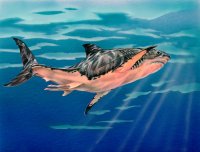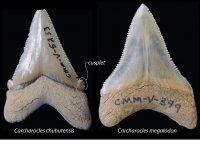SOLOMONS, Md. (March 6, 2019) – Carcharocles megalodon, also known simply as the Megalodon or "Meg", is arguably the largest macro-predator this world has ever known. They populated Earth's oceans for 18 million years, from about 20 to 2.5 million years ago. The immediate ancestor of Megalodon was another huge shark with equally impressive teeth known as Carcharocles chubutensis. In a paper published this week in the "Journal of Vertebrate Paleontology", a team of paleontologists led by Victor Perez - a former intern in the Department of Paleontology at the Calvert Marine Museum - describes how the teeth of the ancestor of Megalodon (i.e., Carcharocles chubutensis) underwent their final transformation into the teeth of Carcharocles megalodon. The very gradual transformation, that took roughly 12 million years, involved the loss of serrated lateral cusplets at the base of the cutting edge of the tooth. Paleontologists study fossils to document how life evolved on Earth. The results of this study are exciting because they show that some small evolutionary changes occur very gradually and may take many millions of years.
From the time of the extinction of dinosaurs 66 million years ago, the triangular teeth of the lineage of sharks that culminated in Megalodon changed in shape, evolved a serrated cutting edge, and increased significantly in size. These massive sharks were well equipped to hunt, kill, and dismember large marine mammals, like whales and dolphins. The loss of the serrated lateral cusplets (an ancestral feature) in these teeth is recorded in sediments preserved in Maryland along Calvert Cliffs on the western shore of the Chesapeake Bay. The sediments in and around Calvert Cliffs preserve the teeth of both species, recording the millions of years during which this final evolutionary transformation in the shape of the Megalodon tooth took place. In the older sediments, most of the teeth bear lateral cusplets, but as one ascends through successively younger strata, the percentage of teeth without lateral cusplets increases until lateral cusplets all but disappear in the youngest beds.
For reasons not entirely resolved, in spite of its global dominance as a marine apex predator, Megalodon became extinct about 3 million years ago. One or more of the following factors may have contributed to their demise: Eruption of a supernova, cooling global temperatures, closure of the Isthmus of Panama, the extinction of groups of whales that Megalodon preyed upon, and/or competition with more modern predators like the great white shark (Carcharodon carcharias).
This research project was a collaboration between the Calvert Marine Museum (Solomons, MD), the University of Florida (Gainesville, FL), the National Museum of Natural History (Washington, D.C.), and the University of Maryland (College Park, MD).
The paper published this in the Journal of Vertebrate Paleontology is entitled:
THE TRANSITION BETWEEN CARCHAROCLES CHUBUTENSIS AND CARCHAROCLES MEGALODON (OTODONTIDAE, CHONDRICHTHYES); LATERAL CUSPLET LOSS THROUGH TIME
In order to share this exciting publication with the community, the Calvert Marine Museum and University of Florida have covered expenses to make the paper open-access. It can be viewed publicly at http://bit.ly/JVPMegTeeth


From the time of the extinction of dinosaurs 66 million years ago, the triangular teeth of the lineage of sharks that culminated in Megalodon changed in shape, evolved a serrated cutting edge, and increased significantly in size. These massive sharks were well equipped to hunt, kill, and dismember large marine mammals, like whales and dolphins. The loss of the serrated lateral cusplets (an ancestral feature) in these teeth is recorded in sediments preserved in Maryland along Calvert Cliffs on the western shore of the Chesapeake Bay. The sediments in and around Calvert Cliffs preserve the teeth of both species, recording the millions of years during which this final evolutionary transformation in the shape of the Megalodon tooth took place. In the older sediments, most of the teeth bear lateral cusplets, but as one ascends through successively younger strata, the percentage of teeth without lateral cusplets increases until lateral cusplets all but disappear in the youngest beds.
For reasons not entirely resolved, in spite of its global dominance as a marine apex predator, Megalodon became extinct about 3 million years ago. One or more of the following factors may have contributed to their demise: Eruption of a supernova, cooling global temperatures, closure of the Isthmus of Panama, the extinction of groups of whales that Megalodon preyed upon, and/or competition with more modern predators like the great white shark (Carcharodon carcharias).
This research project was a collaboration between the Calvert Marine Museum (Solomons, MD), the University of Florida (Gainesville, FL), the National Museum of Natural History (Washington, D.C.), and the University of Maryland (College Park, MD).
The paper published this in the Journal of Vertebrate Paleontology is entitled:
THE TRANSITION BETWEEN CARCHAROCLES CHUBUTENSIS AND CARCHAROCLES MEGALODON (OTODONTIDAE, CHONDRICHTHYES); LATERAL CUSPLET LOSS THROUGH TIME
In order to share this exciting publication with the community, the Calvert Marine Museum and University of Florida have covered expenses to make the paper open-access. It can be viewed publicly at http://bit.ly/JVPMegTeeth


